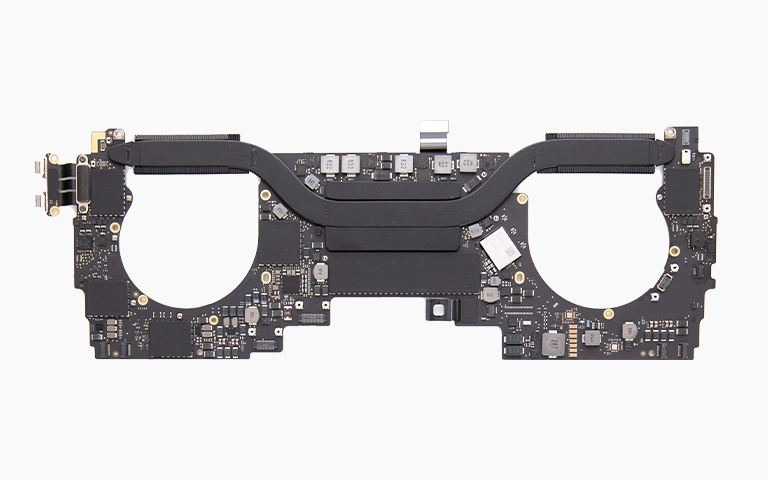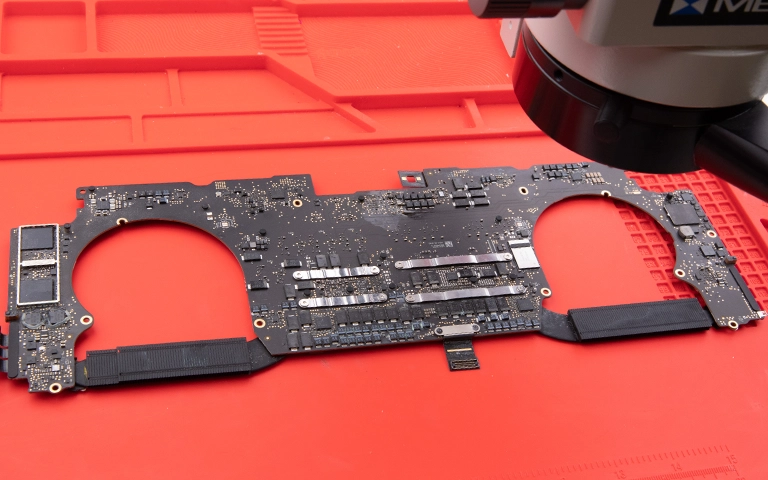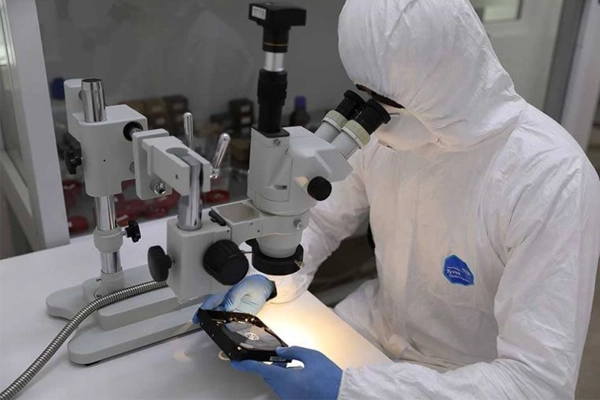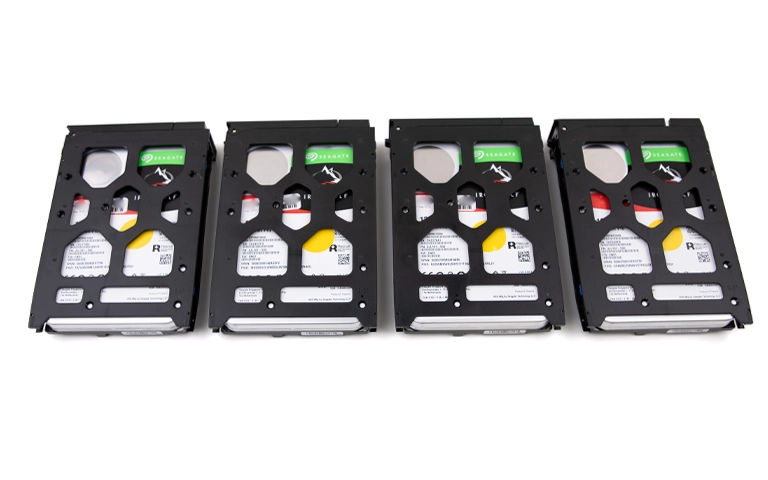Liquid exposure to a Mac device, whether a MacBook, iMac, or Mac Mini, requires immediate and correct action. Delaying or using improper cleaning methods can result in permanent hardware damage and data loss.
This guide outlines the critical first steps to take after a spill, explains the technical risks associated with liquid exposure, and provides an overview of the professional data recovery processes available for mac water damage cases.
Immediate Steps After Spilling Liquid on Your Mac
Time is of the essence. Act fast to minimize damage.
- IMMEDIATELY CUT POWER: Press and HOLD the power button until your Mac shuts down completely. Do not wait for a normal shutdown. If it’s already off, ensure it stays off.
- UNPLUG EVERYTHING: Disconnect the power adapter from the wall and the Mac first. Then, unplug absolutely all peripherals: monitors, USB drives, keyboards, mice, docks, etc.
- INVERT (MacBooks Only): If the spill was on a MacBook (Air/Pro), immediately open it as far as practical and place it upside down in a “tent” shape on a dry, absorbent surface (like a clean towel).
- WIPE EXTERIOR GENTLY: Use a clean, lint-free, absorbent cloth (microfiber is ideal) to carefully blot and wipe away any visible liquid from the outside surfaces – keyboard, trackpad, screen, casing, ports. Do not press hard on keys, as this might push liquid further inside.
- DO NOT POWER ON: Resist the urge to turn the Mac back on “just to check.” Applying electricity to wet circuits is the primary cause of short circuits and permanent component damage.
- DO NOT CONNECT CHARGER: Leave the power adapter disconnected.
- DO NOT USE HEAT: Avoid hair dryers or placing the Mac in direct sunlight or near heaters. Excessive heat can damage components.
Understanding Threats: Short Circuits and Corrosion
Keeping the Mac powered off is vital due to:
The Danger of Short Circuits
Liquids (especially water with minerals, sugary/acidic drinks) conduct electricity. Spilled liquid creates unintended bridges on the logic board. Power application causes shorts, instantly destroying sensitive components (CPU, GPU, SSD controller chips).
The Threat of Corrosion
Even if immediate shorts are avoided (power off), drying liquid leaves residue (minerals, sugars). This reacts with metal components, solder joints, and circuit traces, causing corrosion. Corrosion eats away connections, leading to later failures.
Common Myths and Mistakes to Avoid
The Rice Myth: Why It Doesn't Work
Placing your Mac in a bag of uncooked rice is a popular but ineffective myth. Rice absorbs surface moisture very poorly and slowly. It absolutely cannot draw out liquid trapped under components, inside ports, or within layers of the logic board. Worse, rice dust and particles can contaminate the internals, potentially creating more problems for professional cleaning efforts.
Avoid Using Heat (Like Hair Dryers)
Using heat to dry your Mac risks damaging heat-sensitive components (like plastic keys, screen elements, or even warping the logic board). It can also spread sticky residues further inside. Air drying (after the initial wipe-down and inversion) is passive; it doesn’t remove the harmful residues left behind.
Why DIY Cleaning Inside Your Mac is Highly Risky
pening your Mac to clean spills yourself is discouraged without professional expertise/tools.
- Hidden Damage & Residue: Liquid travels in unpredictable ways. You might clean visible spots but miss corrosive residue hidden under chips, shields, or connectors.
- Specialized Cleaning Needed: Simply wiping with alcohol isn’t enough. Professionals use specific cleaning solutions (like 99%+ isopropyl alcohol), distilled water rinses in some cases, and often ultrasonic cleaning baths to thoroughly remove contaminants without damaging components.
- Risk of Damage During Disassembly/Reassembly: Macs contain delicate connectors and tiny screws. It’s easy to cause further damage (like tearing fragile cables) if you’re not experienced.
- ESD Risk: Internal components are highly sensitive to static discharge. Proper Electrostatic Discharge (ESD) precautions are essential.

DIY Recovery
Risks permanent data loss
Let the Specialists Handle It
DIY attempts often result in permanent data loss. Our certified recovery specialists use advanced tools in controlled environments for the highest success rate.

24/7 Emergency Service
Can Data Be Recovered After Spilling Water on a Mac?
Yes, Mac water damage data recovery is often possible if powered off immediately and handled professionally. Success depends on liquid type, exposure extent, and speed of professional intervention. Recovery usually involves intricate logic board cleaning/repair to access data from the integrated SSD, especially on modern Macs.
Data Recovery Challenges After Liquid Damage
Retrieving data is often more critical than saving the Mac. Liquid damage presents specific challenges, especially with Apple’s modern hardware.
Logic Board & Integrated Storage are Key
Liquid damage frequently impacts the logic board. On most Macs produced in recent years (post ~2016 MacBooks, recent iMacs/Minis):
- The SSD storage (NAND chips) is soldered directly to the logic board.
- Data encryption keys are tied to the logic board’s CPU and Secure Enclave (T2/Apple Silicon chips).
This means your data physically resides on, and is often cryptographically linked to, the potentially damaged logic board. Accessing the data requires getting that specific board (or critical parts of it) functional enough to read and decrypt the storage.
Professional Recovery Process
Data recovery from liquid-damaged Macs often involves intricate component-level repair attempts on the original logic board.
- Expert Cleaning: Thorough removal of all liquid residue and corrosion is the first step.
- Microscopic Inspection & Diagnosis: Identifying damaged components and short circuits.
- Micro-soldering: Skilled technicians may attempt to repair damaged traces or replace small failed components (capacitors, resistors, power ICs) specifically to restore power to the data pathways (CPU, RAM, NAND, controller). This delicate work often happens within a certified cleanroom environment.
- Data Imaging: If the board can be temporarily stabilized, the priority is to create a complete image (clone) of the SSD data using specialized tools.
- File Retrieval: Data is then extracted from the stable image.
Understanding Repair vs. Data Recovery
Sending a liquid-damaged Mac for standard repair (e.g., via Apple) usually results in the replacement of the entire logic board. This fixes the Mac but permanently loses all data from the original board. Professional data recovery focuses intensely on retrieving files from the original damaged components.
Industry-Leading 99% Success Rate
No hidden fees. No surprises. Just expert data recovery you can trust. We handle everything from simple file loss to extreme data recovery cases. If we can’t recover your data, no one can.
Next Steps for Your Liquid-Damaged Mac
After performing the immediate first aid steps:
- Do Not Delay: Corrosion develops over time. The sooner the Mac is professionally assessed and cleaned internally, the higher the chance of successful data recovery and potentially mitigating further damage.
- Do Not Try to Dry It Further Yourself: Leave it powered off and unplugged.
- Contact Data Recovery Specialists Immediately: Call PITS Data Recovery. State clearly that it is a liquid damage case. These cases are often treated with higher urgency.
- Provide Details: Be ready to tell us your Mac model, what liquid was spilled, and exactly when it happened.
Certified & Trusted Data Recovery
PITS Data Recovery specializes in complex data recovery from liquid-damaged Apple devices.







Conclusion: Act Fast, Act Right, Prioritize Your Data
Spilling water on your Mac requires immediate, correct action. Powering off instantly and avoiding mistakes like rice/heat are best first steps. Due to short circuits and corrosion affecting complex internal electronics, professional intervention is highly recommended.
With modern Macs’ integrated storage, DIY repairs risk permanent data loss. Professional data recovery like PITS Data Recovery focuses on specialized cleaning and component-level techniques to retrieve files. Our expertise covers all models: Apple Data Recovery page.








